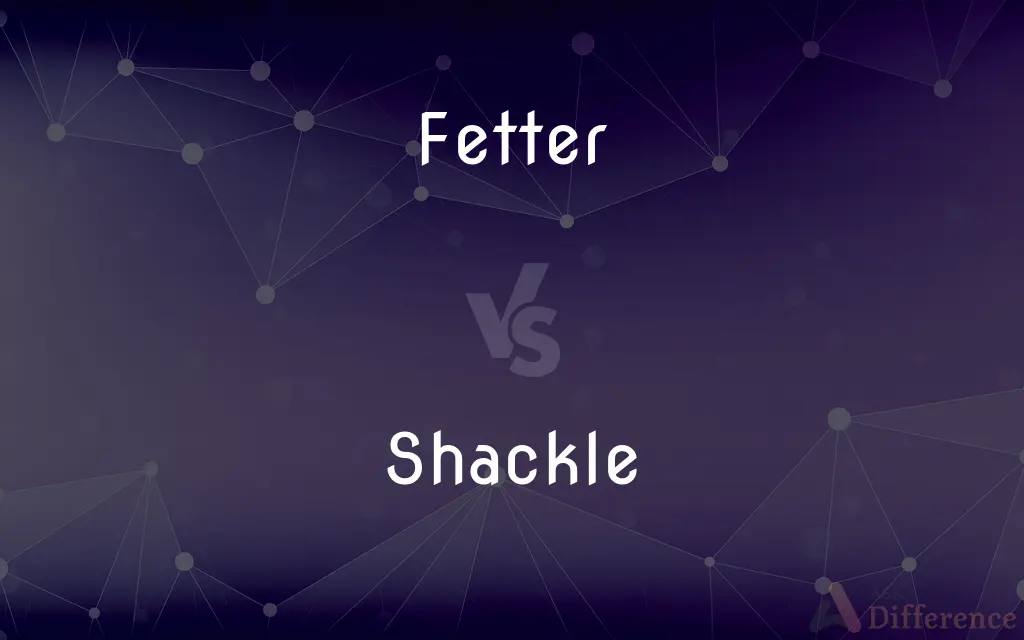Fetter vs. Shackle — What's the Difference?
By Maham Liaqat & Urooj Arif — Updated on April 25, 2024
Fetter typically refers to a chain or manacle used to restrain the feet, while shackle can be used for both limbs and objects, often made of metal.

Difference Between Fetter and Shackle
Table of Contents
ADVERTISEMENT
Key Differences
A fetter is traditionally a chain or shackle for the ankles or feet, used to restrict movement. Whereas, a shackle is a more versatile device, often used in securing prisoners but also in lifting heavy objects with cranes.
Fetter is commonly associated with historical or symbolic restraint, implying not just physical but often metaphorical restrictions. On the other hand, shackle is frequently used in modern contexts, both in physical restraints and in various industrial applications.
The term "fetter" can evoke a more archaic or poetic feel, emphasizing a sense of being bound or restricted in an old-fashioned way. Whereas, "shackle" sounds more contemporary and technical, suggesting robustness and utility in various settings.
Fetter is less commonly used in everyday language, typically appearing in literary or historical discussions. In contrast, shackle is widely used in both everyday and technical language, reflecting its broader application.
Fetter, when used metaphorically, often connotes a limitation or restriction on one's freedom or potential. Conversely, shackle, while also used metaphorically, can imply a stronger, more forceful constraint.
ADVERTISEMENT
Comparison Chart
Usage Context
Primarily historical or literary
Both modern, technical, and everyday
Common Forms
Chains or manacles for the feet
Locks for limbs, tools, equipment
Material
Usually metal
Often metal, includes other materials
Metaphorical Use
Limitations, restrictions
Strong, forceful constraints
Symbolism
Archaic, restrictive
Robust, utilitarian
Compare with Definitions
Fetter
A chain or shackle for the feet.
The prisoner was put in fetters to prevent escape.
Shackle
To impede movement or functionality.
Regulations shackle the growth of small businesses.
Fetter
To restrain with chains.
The guard fettered the thief's ankles together.
Shackle
A restraint or limitation.
Shackles of poverty kept him from pursuing education.
Fetter
To restrict freedom.
The artist felt fettered by conventional aesthetics.
Shackle
A metal link, typically U-shaped, closed by a bolt.
We used a shackle to secure the gate.
Fetter
Anything that confines or restrains.
He threw off the fetters of his oppressive government.
Shackle
A device for lifting heavy objects.
The crane operator attached the shackle to the load.
Fetter
Metaphor for restriction.
She broke the fetters of her upbringing.
Shackle
To confine with chains.
The captors shackled the hostages together.
Fetter
A chain or manacle used to restrain a prisoner, typically placed around the ankles
He lay bound with fetters of iron
Shackle
A shackle, also known as a gyve, is a U-shaped piece of metal secured with a clevis pin or bolt across the opening, or a hinged metal loop secured with a quick-release locking pin mechanism. The term also applies to handcuffs and other similarly conceived restraint devices that function in a similar manner.
Fetter
Restrain with chains or manacles, typically around the ankles
The Supervisor tossed a key to the old slave to unlock the chain that fettered the prisoners together
Shackle
A device, usually one of a pair connected to a chain, that encircles the ankle or wrist of a prisoner or captive.
Fetter
A device, usually one of a pair of rings connected to a chain, that is attached to the ankles or feet to restrict movement.
Shackle
A hobble for an animal.
Fetter
Often fetters Something that serves to restrict; a restraint
The fetters of tyranny.
Shackle
Any of several devices, such as a clevis, used to fasten or couple.
Fetter
To put fetters on; shackle.
Shackle
Often shackles A restraint or check on action or progress
"throwing off the puritanical shackles" (Ben Yagoda).
Fetter
To restrict or restrain
Thinking that is fettered by prejudice.
Shackle
To put shackles on (someone); confine with shackles.
Fetter
A chain or similar object used to bind a person or animal – often by its legs (usually in plural).
Shackle
To fasten or connect with a shackle.
Fetter
(figurative) Anything that restricts or restrains.
Shackle
To restrict, confine, or hamper.
Fetter
(transitive) To shackle or bind up with fetters.
Shackle
A restraint fit over a human or animal appendage, such as a wrist, ankle or finger; normally used in pairs joined by a chain.
Fetter
(transitive) To restrain or impede; to hamper.
Shackle
A U-shaped piece of metal secured with a pin or bolt across the opening, or a hinged metal loop secured with a quick-release locking pin mechanism.
Fetter
A chain or shackle for the feet; a chain by which an animal is confined by the foot, either made fast or disabled from free and rapid motion; a bond; a shackle.
[They] bound him with fetters of brass.
Shackle
A restraint on one's action, activity, or progress.
Fetter
Anything that confines or restrains; a restraint.
Passion's too fierce to be in fetters bound.
Shackle
A fetter-like band worn as an ornament.
Fetter
To put fetters upon; to shackle or confine the feet of with a chain; to bind.
My heels are fettered, but my fist is free.
Shackle
A link for connecting railroad cars; a drawlink or draglink.
Fetter
To restrain from motion; to impose restraints on; to confine; to enchain; as, fettered by obligations.
My conscience! thou art fetteredMore than my shanks and wrists.
Shackle
A length of cable or chain equal to 2 fathoms or 75 feet, or later to 15 fathoms.
Fetter
A shackle for the ankles or feet
Shackle
(transitive) To restrain using shackles; to place in shackles.
Fetter
Restrain with fetters
Shackle
To render immobile or incapable; to inhibit the progress or abilities of.
This law would effectively shackle its opposition.
Shackle
(dialectal) To shake, rattle.
Shackle
Stubble.
Shackle
Something which confines the legs or arms so as to prevent their free motion; specifically, a ring or band inclosing the ankle or wrist, and fastened to a similar shackle on the other leg or arm, or to something else, by a chain or a strap; a gyve; a fetter.
His shackles empty left; himself escaped clean.
Shackle
Hence, that which checks or prevents free action.
His very will seems to be in bonds and shackles.
Shackle
A fetterlike band worn as an ornament.
Most of the men and women . . . had all earrings made of gold, and gold shackles about their legs and arms.
Shackle
A link or loop, as in a chain, fitted with a movable bolt, so that the parts can be separated, or the loop removed; a clevis.
Shackle
A link for connecting railroad cars; - called also drawlink, draglink, etc.
Shackle
The hinged and curved bar of a padlock, by which it is hung to the staple.
Shackle
To tie or confine the limbs of, so as to prevent free motion; to bind with shackles; to fetter; to chain.
To lead him shackled, and exposed to scornOf gathering crowds, the Britons' boasted chief.
Shackle
Figuratively: To bind or confine so as to prevent or embarrass action; to impede; to cumber.
Shackled by her devotion to the king, she seldom could pursue that object.
Shackle
To join by a link or chain, as railroad cars.
Shackle
A restraint that confines or restricts freedom (especially something used to tie down or restrain a prisoner)
Shackle
A U-shaped bar; the open end can be passed through chain links and closed with a bar
Shackle
Bind the arms of
Shackle
Restrain with fetters
Common Curiosities
Can shackles be used for purposes other than restraining people?
Yes, shackles are also widely used in lifting heavy objects and securing items.
What materials are shackles made from?
Shackles are primarily made from metal but can include other durable materials.
Is there a symbolic difference between fetters and shackles?
Yes, fetters often symbolize old-fashioned restraints, while shackles convey a sense of robust utility.
Can fetters be used on other body parts besides the feet?
Traditionally, fetters are designed for the feet, but the term can be applied metaphorically to other restraints.
How does the metaphorical use of fetter and shackle differ?
"Fetter" metaphorically implies limitations, while "shackle" suggests more forceful constraints.
What is the historical significance of fetters?
Fetters have a long history in penal systems as tools for humane restraint.
What is the primary use of a fetter?
Traditionally, fetters are used to restrain a person's feet or ankles.
Are fetters still used today?
Fetter is more often used metaphorically or in historical contexts today.
Are shackles adjustable?
Yes, many shackles are adjustable to fit different sizes and purposes.
Can shackles be used in nautical applications?
Yes, shackles are essential in various nautical applications, including securing sails and rigging.
Share Your Discovery

Previous Comparison
Mirth vs. Joy
Next Comparison
Gripping vs. GripingAuthor Spotlight
Written by
Maham LiaqatCo-written by
Urooj ArifUrooj is a skilled content writer at Ask Difference, known for her exceptional ability to simplify complex topics into engaging and informative content. With a passion for research and a flair for clear, concise writing, she consistently delivers articles that resonate with our diverse audience.
















































